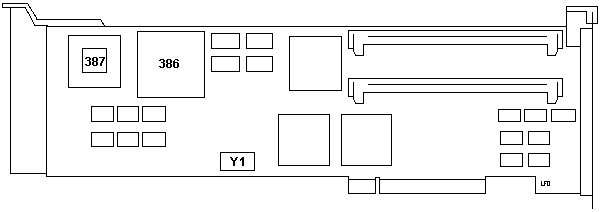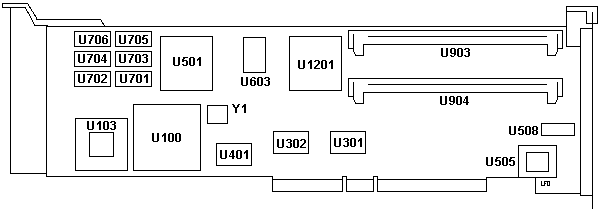|
Since there is little (read NO) documentation, this will be messy... @006E.ADF - Aox MicroMASTER 386 32bit ADF v1.5 I006E.ADF - Initialization File for @006E.ADF @706D.ADF - AOX MicroMASTER 486/386 ADF v1.4 I706D.ADF - Init file for @706D.ADF @706F.ADF - AOX MicroMASTER 386 ADF v1.1 @706F.ADF - AOX MicroMASTER 386 ADF v1.2 rename to @706F.ADF Installation Guide for MCMaster MC133PD or MC66PD MCMaster Processor Upgrade Files MCMR236.EXE MCMaster Utility Diskette v2.36 BIOS update to 2.36 MCM235.EXE MCMaster Utility Diskette v2.35 BIOS update to 2.35 MC235I.EXE MCMaster Utility Diskette v2.35I - BIOS Update to 2.35i AMM124OU.ZIP MicroMaster Utility Diskette v1.24 For early 16 and 32 bit MicroMasters Thanks to Jiri Zlamal! Aox MicroMaster 386 16-bit (706F) MMSETUP.EXE [-mm=xy] sets installed SIMM sizes (x/y = 1/2/4). Requires UM.HEX = current BIOS ROM Intel Hex file. If no -mm= input then select from displayed combinations. MMDIAG.EXE If testing ROM will search for UMvrr.HEX based upon current ROM v.rr (v=version, rr=release). If not found will try UM.HEX, if it can be found. MICROADF.EXE MicroMaster .ADF files Even Earlier 386DX MicroMaster Limits of SC.EXE for Model 70 / 80 and Like Systems WBST Clarke: As initially created, the Model 70/80 Reference & Diagnostics Diskette v1.12 only has SC.EXE (System Configuration utility) v2.1, which needs updating to at least v2.2. Easy SC.EXE Upgrade XGAOPT.exe Installs the updated (as of '92) SC.EXE, XGA/2, and SCSI, SCSI w/cache ADFs, plus updated *.dgs. For 5565, 5657, 70486, 7080, 7677, 90, 95, P70, P75. For any system with refdisks after 92/93, these files are probably redundant. MMIDD New Option v1.03 (common to all AOX / Kingston files) A new option has been added to the installable device driver MMIDD for the 16 bit MicroMASTER 386. The version is 1.03 and it is to be used with MicroMASTER code rev 1.21 or later (it checks). The new option is r where r stands for relocate. This will relocate the resident interrupts (int 15h, 13h, 75h, 4bh) from the top of conventional memory (9f00h segment) to lower memory in the device driver. This eliminates problems with programs that don't know how to deal with memory being used between end of low memory and the extended bios data area (like Windows). It also sets up to look for emm386 (and possibly some other LIMulators) and envelops it to work properly with the VDS calls (int 4b). Overview of Installing an Initializer In the early days of the PS/2 there was no easy way to install non-IBM memory adapters in a way that the system 'saw' the memory, so IBM issued an interim method of installing an initializer on the first track of the hard disk (track 0). Later IBM changed the set configuration program on the reference disk (SC.EXE) to allow for installation of these initializers. However, not everyone has these new set configuration programs. Because the Adapter Description File (ADF) for the memory adapters would cause an error if it had the new keyword in it and was run on an old version of set configuration, some vendors are not using the newer method, but staying with the older interim method. The new set configuration program also removes initializers which it does not know about, so if two vendors use different methods, the older method must be used after the newer method. This, however, causes the initializer installed later to execute later. Because the MicroMASTER must be initialized after all other memory boards, the MicroMASTER initializer must be installed last and that will not be the case if the MicroMASTER uses the new method and the Above Board uses the old. Therefore Aox provides a program which will install our initializer after all others. Intel also provides a program, SOFTSET, which, among other things, will install the initializer for the Above Board. MicroMaster 386 32 Bit FCCID: GZNMM386-25-32
U1201 marked 38620/25, Rev 65-3 suggests Y1 could be upgraded to 50MHz osc. Maybe. The serial number is on the reverse of the blue card guide. Note the addition of a flash ROM chip and a cache
chip in the lower right corner. The Memory/DMA
controller ASIC is a Plus Logic chip. Note also that the
adapter is 32 bit. MicroMaster 386 16 Bit  MMDIAG.EXE has a switch, /TESTPAL which Tests U707 for rev 3 part on type A16 MM 386 boards. We are still confused, but WBST expects U707 (Programmable Array Logic) chip is responsible for bus interface and address decoding implementation and the like. WBST Clarke writes: It's the earlier/earliest Version 1 386DX-25 16-bit adapter, with Adapter Id. 706F, presumably the Version 1 486 adapter has adapter Id. 706E, and the 32-bit Version 2 equivalents have Id.s 006E and 006F (what 008E is I'm unsure). Jiri/George's software package contained the v1.2 ADF, which works well, and included the long-missing MMSETUP utility to "flash" the installed SIMM sizes, as well as the microcode levels v1.19, v1.21 and its current v1..24 HEX files, and Track-0 initializer, device driver etc. The later 32-bit (Version 2?) adapters are fully POS-configured (and report installed memory) with the later v2.2 and upwards System Configuration utility, SC.EXE. "Apparently, the earliest versions of the Aox 386 (Id. 706F) and 486 (Id. 706E?) adapters came with totally different onboard firmware and possibly BIOS code, as well as an "EEPROM configuration utility" - MMSETUP, which seems to have been responsible for writing installed SIMM, Interrupt line select and other details normally done via POS configuration ADFs in the later versions. This configuration utility (and any associated documentation/help files) has not been uncovered in many, many years, despite our pillaging of the Kingston support site when that still contained some related, archived files." From Dr. Jim I also have an older, more primitive, AOX 25 MHz version of this card. Lacks the video local-bus connector and the ASICs are different. Uses the same ADF and diags, though. Not moddable in the same fashion as the Kingston version, and I have a hunch it wouldn't handle 33 anyway. Even Earlier 386DX MicroMaster  G325-5004-00 Personal Systems/Issue 4, 1989 Page 99 4x 30 pin SIMMs, looks to be 64KB of L2. |
